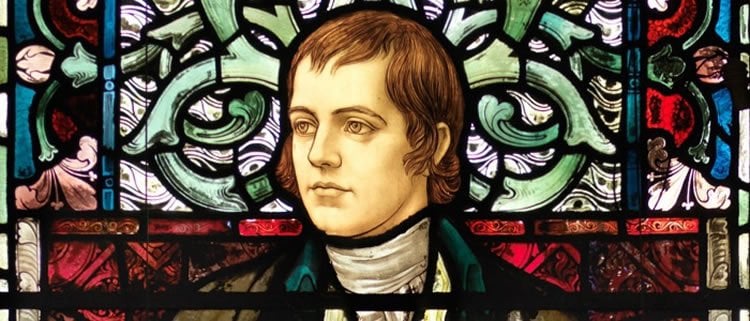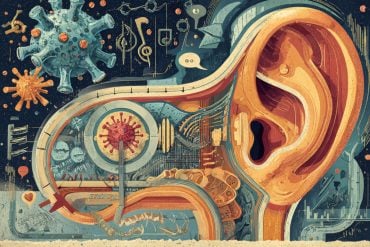Summary: Researchers examine the personal writings of Robert Burns, Scotland’s national bard, and conclude he may have suffered from bipolar disorder.
Source: University of Glasgow.
Researchers at the University of Glasgow suggest Robert Burns may have had bipolar disorder, according to a paper published in The Journal of the Royal College of Physicians of Edinburgh.
More than 800 letters and journals have helped the academics to analyse the mental state of Robert Burns.
The project also looked beyond Scotland’s national bard’s correspondence to his relationships and day-to-day life in a bid to establish if he had a psychiatric disorder.
Now the Glasgow academics carrying out the four year project, which started in 2015, say they have some evidence to suggest that Burns may have suffered from bipolar disorder, with the Bard’s moods cycling between depression and hypomania.
This might explain the writer’s periods of intense creativity, temperamental personality and unstable love life.
The research looked at blocks of letters across four separate time frames over nine years from 1786 to 1795, testing the use of the poet’s letters as a source of evidence relating to his mental health.
The findings – Mood disorder in the personal correspondence of Robert Burns: Testing a novel inter-disciplinary approach – are published in The Journal of the Royal College of Physicians of Edinburgh.
The first block of letters covered a three-month period centred on December 1793, specifically chosen as it was a known period of melancholia or depression identified by Burns in his writing.
At this time Burns’s letters show him feeling “altogether Novemberish, a damn’d melange of fretfulness and melancholy…my soul flouncing & fluttering”.
This sample acted as a base to show symptoms of lowered mood, mild depression and melancholia with two of the letters meeting the criteria for clinical depression.
There were also gaps, over two weeks between the 3-15 December 1793, where the poet appeared to have written no letters which could indicate some social withdrawal.
The other three blocks of letters acted as further pilot tests of the methodology – with an individual not connected to the study randomly selecting three different starting points for each of the samples. This blind sample had a total of 104 letters assessed.
Further analysis will be carried out by the project which will allow the construction of a “life mood map” to chart the variations of Burns’s mood over his lifetime offering a fuller understanding of Scotland’s national bard.
The authors of the report are Moira Hansen, Lord Kelvin Adam Smith PhD student based at the University’s College of Arts; Professor Daniel Smith, Professor of Psychiatry at the University’s Institute of Health and Wellbeing, and Professor Gerard Carruthers, Co-Director of the University’s Centre for Robert Burns Studies.
Moira Hansen, the principal researcher on the project, said: “Blue devilism was the term Burns used to describe periods of depression which he suffered, periods which affected his life and his work – not something you would automatically expect of someone with a worldwide reputation for knowing how to enjoy himself – and something that our project is properly studying for the first time.
“During his lifetime and since his death, Burns has often been viewed as a tortured poetic genius which helped to explain his reputation as a lover of life, women and drink. But it is only in the last two decades that it has been mooted he may have suffered from a mood disorder.”
She added: “This project is using modern day methods to track and categorise the bard’s moods and work patterns.
“The work published in this article shows that we can used Burns’s letters as a source of evidence, in place of having the face-to-face interviews a psychiatrist would normally have.
“We have pinpointed evidence which showed bouts of increased energy and hyperactivity, and periods of depression and a withdrawal from day-to-day life. Further work to take account of the conventions of letter writing in the 18th century, who Burns was addressing his letters to and the different activities he was involved in at the various stages of his life is still being carried out. But we now believe Burns may have had what we would recognised today as bipolar disorder. We will carry out further in-depth analysis to create a mood map of his life to chart these highs and lows linking it to what was happening both in his private and public life to judge how it impacted on his writing.”
Professor Daniel Smith, Professor of Psychiatry at the University of Glasgow, said: “Today there is greater awareness of the importance of mental health issues and we hope our project can be part of this debate. Carefully assessing the mood and behaviour of one of Scotland’s iconic figures, using both medical and literary expertise, is a new approach that helps to paint a picture of his mental health and how it affected both his life and writing.
“Obviously it hasn’t been an easy task given our subject has been dead for more than 200 years. We hope that the possibility that Scotland’s national bard, a global icon, may have had bipolar disorder will contribute to discussions on the links between mental illness and creativity. This work might also help to destigmatise psychiatric disorders such as bipolar disorder and depression.”
Professor Gerard Carruthers, Co-Director of the University’s Centre for Robert Burns Studies, said: “Robert Burns was a complicated man, with an amazing catalogue of work produced in a short lifetime before he died at 37. Today he holds a fascination not just for Scots but a worldwide audience.
“The fact that Scotland’s national bard may have had bipolar disorder is part of the telling and understanding of all aspects of the bard’s story to reveal a more accurate picture of the real Robert Burns.
“I am delighted to be involved in such important cross-disciplinary research which I hope will help to inform today’s debate on mental health illness.”

The project called Melancholy and low spirits are half my disease: Physical and mental health in the life and works of Robert Burns, officially started in October 2015 and is due to be completed in 2019.
It considers three main sections. The first examines the personal writing of Burns – his letters, journals and notebooks – looking at the evidence which relates to his physical and mental health, as well as taking account of testimony from those who knew him in life.
Armed with this better understanding of Burns’s mental health, the second section will explore the impact on Burns’s wider life – key decisions about his employment, his relationships with women, and with alcohol. The third section will go on to analyse some of his poems and songs, looking for evidence of his mental health affecting what he was writing, whether it was the subject matter, the quantity, the quality or the language he used.
In gaining a better understanding of the man behind the myth, the project will help create a more accurate representation of the real Robert Burns. The project website is https://bluedevilism.wordpress.com/
Letter Block 1 was from 29 October 1793 to 12 January 1794. It covers a period of mild depression identified by Burns himself in his writing and used as a test for the suitability of letters as a source of evidence.
Letter Block 2 was from 29 November 1786 to 5 February 1787. He had recently arrived in Edinburgh and the Kilmarnock edition of his Poems had been published in July 1786. Although there is evidence of exaggeration and grandiosity which may point to hypomania, there is stronger evidence of an episode of depression which included anxiety about being exposed to the public.
Letter Block 3 covered a period 28 May 1790 to 17 January 1791 – a period of great physical and creative activity for Burns. At this time in the poet’s life, assuming full-term deliveries, both his wife Jean Armour and Anna Park, a local barmaid, fell pregnant in late June or early July by Burns.
Letter Block 4 covered 22 September 1794 to 8 March 1795 – when Burns was living in Dumfries with Jean Armour and their five children, working as an excise officer and heavily involved in writing, collecting and editing songs for Edinburgh publisher George Thomson. This was a period with sporadic days indicative of hypomania but overall no conclusive evidence of any prolonged periods of hypomania.
Source: University of Glasgow
Publisher: Organized by NeuroscienceNews.com.
Image Source: NeuroscienceNews.com image is adapted from the University of Glasgow news release.
Original Research: Open access research for “Mood disorder in the personal correspondence of Robert Burns: testing a novel interdisciplinary approach” by M Hansen, DJ Smith, and Carruthers in Journal of the Royal College of Physicians of Edinburgh. Published June 2018
doi:10.4997/JRCPE.2018.212
[cbtabs][cbtab title=”MLA”]University of Glasgow “Poet Robert Burns May Have Suffered From Bipolar Disorder.” NeuroscienceNews. NeuroscienceNews, 12 June 2018.
<https://neurosciencenews.com/robert-burns-bipolar-9317/>.[/cbtab][cbtab title=”APA”]University of Glasgow (2018, June 12). Poet Robert Burns May Have Suffered From Bipolar Disorder. NeuroscienceNews. Retrieved June 12, 2018 from https://neurosciencenews.com/robert-burns-bipolar-9317/[/cbtab][cbtab title=”Chicago”]University of Glasgow “Poet Robert Burns May Have Suffered From Bipolar Disorder.” https://neurosciencenews.com/robert-burns-bipolar-9317/ (accessed June 12, 2018).[/cbtab][/cbtabs]
Abstract
Mood disorder in the personal correspondence of Robert Burns: testing a novel interdisciplinary approach
Robert Burns has long been recognised as someone who experienced episodes of melancholia, but no detailed, systematic and objective assessment of his mental health has been undertaken. We tested a novel methodology, combining psychiatric and literary approaches, to assess the feasibility of using Burns’s extensive personal correspondence as a source of evidence for assessing the presence of symptoms of a clinically significant mood disorder. We con rmed the potential of this approach and identi ed putative evidence of episodes of depression and hypomania within the correspondence. While not conclusive of a formal diagnosis of bipolar disorder, this work highlights a need for further systematic examination of Burns’s mental health and how this may have in uenced his work.






